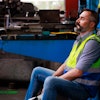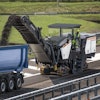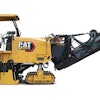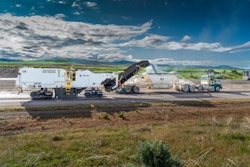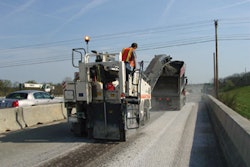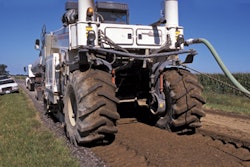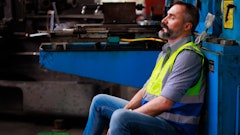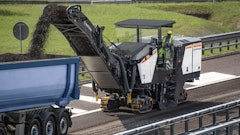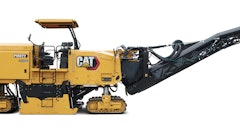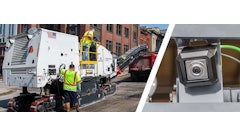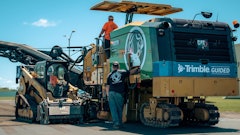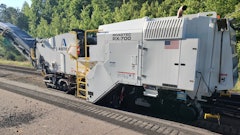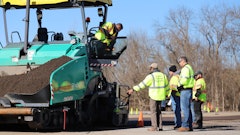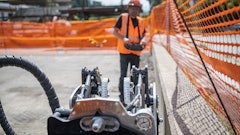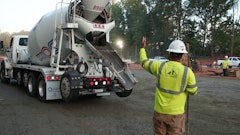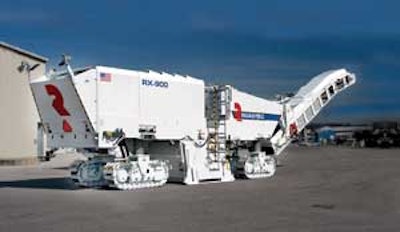
Every contractor who owns construction machinery knows it's important to generate as many profitable hours as possible out of any given piece of equipment. So when Lindsey Contractors Inc. of Waco, TX needed to pulverize a stretch of a county road, they decided to use their Roadtec RX-900 cold planer instead of a traditional reclaimer/stabilizer.
The job consisted of 1.5 miles of an old chip seal road just south of Dallas. The road was 24 feet wide, and covered with 4.5 inches of flex base (aggregate) and three different layers of ½-inch chip seal from previous preservation efforts. Lindsey Contractors was looking to use their RX-900 cold planer to pulverize the 1.5-inch layer of the chip seal and work it into the flex base all in one operation. Two simple changes from the regular milling mode were made and the crew was ready to get some profit-generating hours out of the RX-900 that did not involve traditional milling: the front-loading conveyors were turned off and the rear cutter housing door was opened to leave the processed road material on the ground.
Executing the job
Lindsey's milling crew had to experiment with the cold planer to find out how to produce the best gradated material to achieve the desired compaction results.
First, the crew ran the machine in both directions to check the gradation results. The gradation of milled material will be different, depending on whether the drum is up-cutting or down-cutting. The up-cut material graded evenly from dust on top to two inches on the bottom. The down-cut method placed the larger material on top. In this case, the crew liked the gradation achieved when up-cutting. Roadtec's Terry Leber, who was observing the work, says that "as you dug down in the windrow, the material got coarser as you dug deeper." Then the crew adjusted the rear cutter housing door to spread, or screed, the material in the cut.
The machine traveled in the forward direction exactly as if they were cold milling with the conveyors turned off. The rear cutter housing door was opened just enough so that the pulverized material stayed on the ground, and the size of the opening was set to let the material flow under the door and to screed the windrow flat.
A grader followed directly behind the RX-900, establishing lateral profile and shaping the road. A roller was then used to compact the material. Traffic was then allowed to run on the newly compacted surface until the contractor returned later to complete the operation with a 2-inch layer of hot mix.
More work, same machine
Essentially, the RX-900 cold planer was used to accomplish the same process that a rubber-tired reclaimer/stabilizer would have completed. It's a good example of how to use a cold planer like the RX-900 to complete more days of work per year. This allows the contractor to justify his first purchase of a cold planer or ownership of a larger cold planer.
Keep in mind that pulverizing of bituminous or flex base can easily be done with a cold planer, but a cold planer cannot work in wet sticky soil (subbase). The center scrolling design of a typical highway cold planer would cause the cutter drum to plug up. An operation involving subbase would require a rubber-tired soil stabilizer/reclaimer, which has a different style cutter drum that does not collect the material to the center like a cold planer and has self-cleaning teeth that prevent plugging.
Multi-tasking equipment can make a big difference to your bottom line. Considering just cold planers, a bi-directional model allows you to use the machine as a down-cut and up-cut pulverizer, in addition to the traditional milling jobs it usually does.
When looking at the return on your machine investment, you can see the potential if you're able to add several days of pulverizing work to the year's milling projects for the machine. Moreover, a cold planer that can mill forward as an up-cut machine and backward as a down-cut machine can make jobs easier when there are tight working conditions or heavy traffic volume.
The crew can mill the first cut in the traditional up-cut mode, crab sideways and mill in the reverse direction in the down-cut mode, rather than turn around or deadhead back to the start. To make the machine even more versatile, an asphalt emulsion package consisting of pumps and meters can be added for cold-in-place recycling work.
Seek manufacturer's help
It's important to note that no tools or machines should ever be used for a purpose they were not intended. You should never modify equipment without the help of the manufacturer. You'll likely void any warranties or service contracts you may have, and an unsafe situation may be created which can jeopardize the crew.
The manufacturer will be able to design modifications in a safe and effective way, and can deliver your machine with them in place.
Roadtec's Vice President of Engineering Dave Swearingen says, "We work with customers on special applications. If there is a way, we'll make it work."
Swearingen's staff has provided solutions from outrigger wheels on mills that work on sloped surfaces such as racetracks to special systems on pavers to keep material and fuel flowing while working on slopes. Another modification Roadtec has successfully provided in the United States and internationally is outfitting the RX-900 cold planer with a reverse gearbox, allowing the milling machine to pull as well as push other equipment as part of recycling train.
The reverse-gearbox RX-900 up-cuts and rear-loads while pushing a cement slurry tanker and pulling a screening/crushing/mixing train plus an asphalt tanker. A recirculating JCI single deck screen (3/4-inch passing) and impact crusher sizes the material, which is then weighed and mixed with asphalt emulsion. Then the train lays down a windrow for a Carlson pick-up machine to feed the paver.
In the case of Lindsey's RX-900 cold planer, modifications were not even required to use the machine as a pulverizer. At top cutting speeds of 125 fpm, it took an average of approximately one hour per pass to cut the 1.5 miles. No water was used. Cutter teeth looked nearly new when the job was completed. In Leber's words, "the contractor was very pleased."
